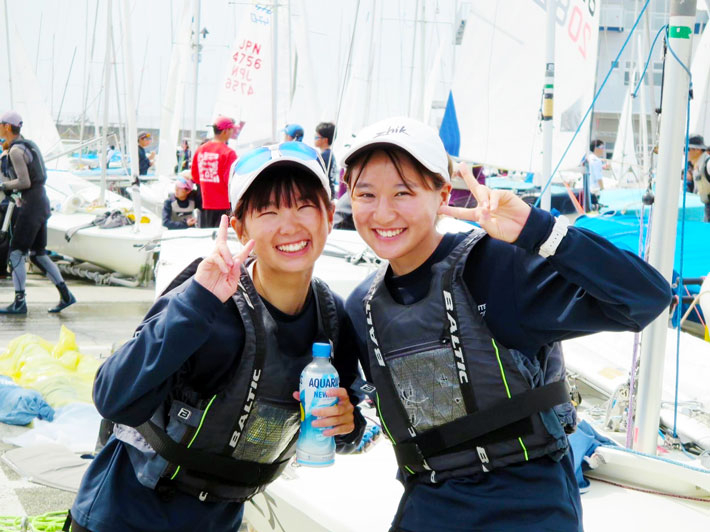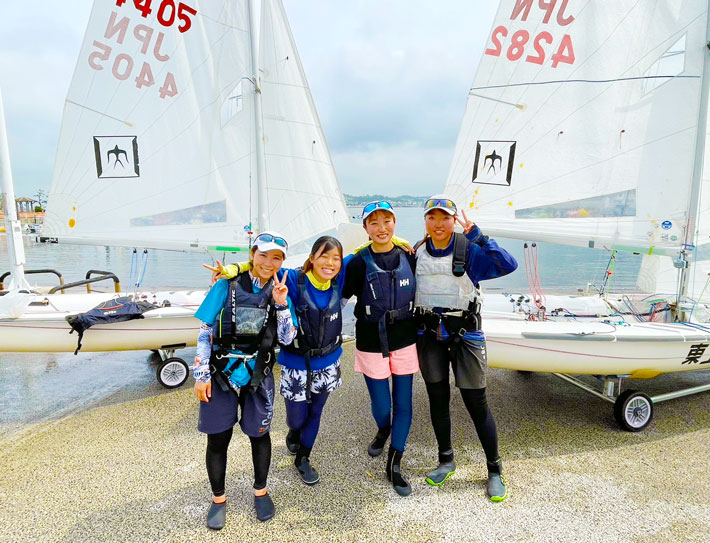Two crews from the Tokyo Tech Sailing Team have qualified for the 31st All Japan Women’s Student Sailing Championships to be held from September 22 to 25 off the coast of Hayama, Kanagawa Prefecture. The Institute’s sailors secured their places in the nationwide competition after finishing 11th in the Snipe class1 and 13th in the 470 class2 at the Kanto region qualifiers held from June 10 to 18.
This will be the first All Japan Women’s Student Sailing Championships for Tokyo Tech in four years. Crews will battle it out in the Snipe and 470 classes.
Snipe class crew
- Helmsperson3 Miho Yako, 3rd year, Materials Science and Engineering
- Crew member Saki Kobayakawa, 3rd year, Architecture and Building Engineering
- Crew member Yu Endo, 2nd year, Life Science and Technology
Comments from Miho Yako
This will be our first time to participate in the All Japan Women’s Student Sailing Championships. In the qualifying races, we enjoyed the fruits of our daily practice, but there were also races during which we felt frustration. There are similarities between academics and sailing in that they both involve self-exploration and there is never one correct answer. We will continue to train proactively and with even more determination so that we can achieve better results in the upcoming competition. We will give it our best while enjoying the race. Thank you for your support.

Yako (left) and Kobayakawa
470 class crew
- Helmsperson Yui Ito, 2nd year, Life Science and Technology
- Crew member Manami Sasazawa, 2nd year, Chemical Science and Engineering
Comments from Manami Sasazawa
We are very pleased to qualify for the All Japan Women’s Student Sailing Championships for the first time. I am looking forward to competing against athletes from all over Japan, which will be something special. We will practice hard every day, keeping in mind what we learned at the recent qualifiers. On the day of the championships, we hope to be prepared fully in terms of technique, strategy, and knowledge of the rules. At times, the qualifiers were frustrating as we were overtaken due to our inexperience. During the period leading up to the competition, we will engage in practical training so that we can achieve significant results at the competition. We look forward to your support.

Ito (2nd from left) and Sasazawa (far right)
Sailing: A sport of mind and body
Competitive sailing is a sport that requires a high level of strategy and tactics, such as reading the constantly changing winds and tides, and deciding on the best course for the boat while maintaining speed. In a race, participating boats start at the same time, sail around buoys in the prescribed order a specific number of times, and compete to cross the finish line first. At the All Japan Women’s Student Sailing Championships, sailors compete in two classes — the Snipe class and the 470 class.
Snipe-class dinghies use two sails — a mainsail and a jib. Speed can be hard to come by, so sailors must utilize the wind skillfully while maneuvering strategically in relation to the other boats. Sailors lean over the edge of the boat to achieve balance while holding on to a belt with their feet.
In addition to a main sail and a jib, 470-class dinghies also use a spinnaker sail. This gives the boat more speed than a Snipe-class dinghy, but also makes balancing more difficult. To prevent the boat from capsizing, “trapeze” wires are attached to the boat, allowing sailors to hang outside the vessel with their feet on the edge of the dinghy.
The Snipe class is a 4.72-meter sailboat designed by William F. Crosby in 1931. It was originally intended as a boat that can be rigged and launched in a short time, and has maintained its position as one of the most popular two-person racing sailboats since its creation.
The 470 (four-seventy) class, so named due to its 4.7-meter length, is a sailboat designed to plane easily. Sailing the boat efficiently requires strong teamwork from its two crew members. Designed in 1963 by Frenchman André Cornu, the 470 class has been an Olympic sailing class since 1976.
Person at the helm, i.e., the lever or wheel steering a boat or ship. Skipper.






